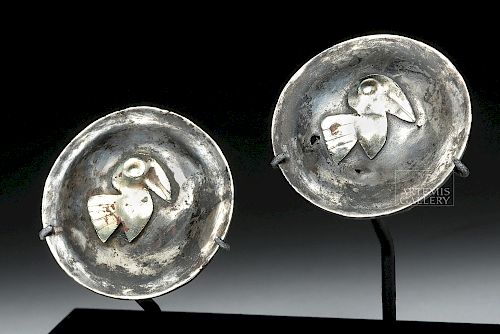Nazca Silver and Gold Ear Ornaments - 18.1 g
Lot 17
About Seller
Artemis Fine Arts
686 S Taylor Ave, Ste 106
Louisville, CO 80027
United States
Selling antiquities, ancient and ethnographic art online since 1993, Artemis Gallery specializes in Classical Antiquities (Egyptian, Greek, Roman, Near Eastern), Asian, Pre-Columbian, African / Tribal / Oceanographic art. Our extensive inventory includes pottery, stone, metal, wood, glass and textil...Read more
Estimate:
$1,800 - $2,800
Absentee vs Live bid
Two ways to bid:
- Leave a max absentee bid and the platform will bid on your behalf up to your maximum bid during the live auction.
- Bid live during the auction and your bids will be submitted real-time to the auctioneer.
Bid Increments
| Price | Bid Increment |
|---|---|
| $0 | $25 |
| $300 | $50 |
| $1,000 | $100 |
| $2,000 | $250 |
| $5,000 | $500 |
| $10,000 | $1,000 |
| $20,000 | $2,500 |
| $50,000 | $5,000 |
| $100,000 | $10,000 |
| $200,000 | $20,000 |
About Auction
By Artemis Fine Arts
May 10, 2018
Set Reminder
2018-05-10 10:00:00
2018-05-10 10:00:00
America/New_York
Bidsquare
Bidsquare : Fine Ethnographic / Asian / Ancient Art
https://www.bidsquare.com/auctions/artemis-gallery/fine-ethnographic-asian-ancient-art-3213
Featuring antiquities from around the world including Pre-Columbian, Tribal, Classical, Asian, so much more! Artemis Fine Arts info@artemisgallery.com
Featuring antiquities from around the world including Pre-Columbian, Tribal, Classical, Asian, so much more! Artemis Fine Arts info@artemisgallery.com
- Lot Description
Pre-Columbian, South Coast Peru, Nazca, ca. 100 to 300 CE. An attractive pair of 10K gold and silver earspools, each one decorated with a seabird assuming an endearing pose, as if in flight, with outspread wings showing incised feathers that appear to be fluttering, an ovoid body, and an alert countenance with a proud beak and a bulging round eye delineated in repousse. The birds are comprised of 10K gold. Their surroundings and the backs are silver. A lovely example of finely crafted Nazca jewelry, replete with elegant forms and rich iconography, for in the Pre-Columbian world, birds were associated with the celestial realm and believed to act as messengers between humans and their deities. Size: 1.625" L x 1.5" W (4.1 cm x 3.8 cm); 2.875" H (7.3 cm) on included custom stand. Weight: 18.1 grams
For the ancients of the Americas, dress was an indication of wealth and status. Ear ornaments such as these would have been worn by a noble to symbolize his rank. The Spaniards called these nobles orejones meaning "big ears" because their earlobes had become so stretched. Viewed as supernatural winged creatures, bird imagery was included in mythology and rituals, and the forms of various feathered friends - parrots, owls, pelicans, hummingbirds, ducks, vultures … - were oftentimes used to decorate the garments of rulers as well as their jewelry. In addition, artists oftentimes anthropomorphized birds in wares and ornaments associated with combat, headhunting, and other ritualistic activities such as shields, tumis, and maces.
According to the curatorial team of the Metropolitan Museum of Art in New York, "In Nazca religion, which highly valued plants, animals, and fertility, birds as headhunters participate in the regeneration of life. Many of the Nazca geoglyphs take the shape of birds in flight. These monumental figures traced on the surface of the desert have been successively interpreted as boundary markers, water spring markers, and ritual paths suitable for processions. New interpretations suggest that the location and orientation of geoglyphs are connected with geological faults and channels of underground water, which were exploited by Nazca agriculturalists. Nazca painted ceramics and precious gold ornaments represent creatures in flight echoing the shape and style of geoglyphs (1979.206.511,.512)." (https://www.metmuseum.org/toah/hd/bird/hd_bird.htm)
Provenance: private Hawaii, USA collection; ex-Hirsch Collection, Germany
All items legal to buy/sell under U.S. Statute covering cultural patrimony Code 2600, CHAPTER 14, and are guaranteed to be as described or your money back.
A Certificate of Authenticity will accompany all winning bids.
We ship worldwide and handle all shipping in-house for your convenience.
#132610Normal surface wear/tarnish commensurate with age. One tiny perforation behind tail of one bird. Some fissures and losses to plug section.Condition
- Shipping Info
-
All shipping is handled in-house for your convenience. Your invoice from Artemis Gallery will include shipping calculation instructions. If in doubt, please inquire BEFORE bidding for estimated shipping costs for individual items.
-
- Buyer's Premium



 EUR
EUR CAD
CAD AUD
AUD GBP
GBP MXN
MXN HKD
HKD CNY
CNY MYR
MYR SEK
SEK SGD
SGD CHF
CHF THB
THB
















